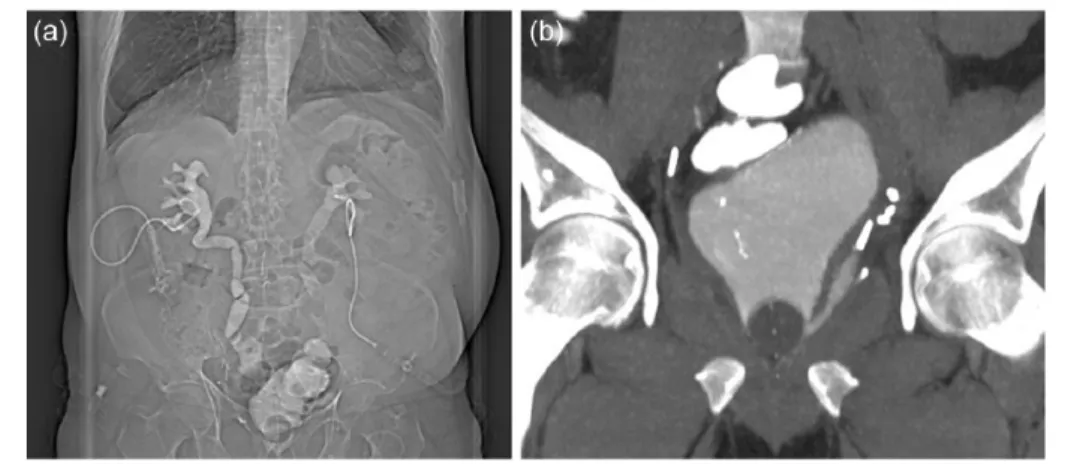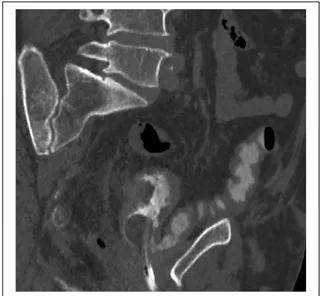https://doi.org/10.1177/0391560318758939 Urologia Journal
2019, Vol. 86(1) 39 –42 © The Author(s) 2018 Article reuse guidelines: sagepub.com/journals-permissions DOI: 10.1177/0391560318758939 journals.sagepub.com/home/urj
UJ
Urologia JournalIntroduction
Entero-neovesical fistula is a rare complication after radi-cal cystectomy (RC) and orthotopic ileal bladder substitu-tion, occurring in about 1.5% of cases in representative series.1,2 The abnormal communication can develop
between the neobladder and any bowel tract, with the small bowel being the most commonly involved segment. Typical presenting symptoms are faecaluria, pneumaturia, recurrent urinary tract infections and abdominal pain. Risk factors include history of pelvic radiation, chemotherapy
Entero-neovesical fistula after radical
cystectomy and orthotopic ileal
neobladder: A report of two cases
requiring surgical management
Vito Palumbo
1, Gianluca Giannarini
2, Enrica Subba
1,
Antonino Inferrera
1and Vincenzo Ficarra
1Abstract
Introduction: Entero-neovesical fistula is a rare complication after radical cystectomy and orthotopic ileal bladder
substitution. Typical presenting symptoms are faecaluria, pneumaturia, recurrent urinary tract infections and abdominal pain. Risk factors include history of pelvic radiation, chemotherapy and abdominal surgery, as well as diverticular colonic disease, inflammatory bowel disease and traumatic pelvic injury. The paucity of cases reported in the literature makes the management of this threatening complication very challenging. Conservative treatment has only anecdotally been reported.
Case description: We describe two cases of entero-neovesical fistula with different presentation, which both
required an immediate surgical treatment. The former patient was admitted to the emergency room with faecaluria, complete urinary incontinence and fever 2 years after radical cystectomy, and a fistula between the Y-shaped neobladder and the bowel anastomosis was detected. He had previously undergone chemotherapy because of tumour progression. Undiversion into an ileal conduit was required. The latter patient presented with faecaluria 20 days after an uneventful radical cystectomy, and a fistula between the Vescica Ileale Padovana neobladder and the sigmoid was documented. Treatment included resection of the sigmoid with several small diverticula, temporary ileostomy and closure of the neobladder fistula.
Conclusion: Conservative treatment of entero-neovesical fistula can be attempted only in patients with small openings
in the small bowel and no systemic symptoms. In all other cases, surgical treatment with bowel resection and either closure of the neobladder opening or undiversion should be the preferred option.
Keywords
Urinary bladder neoplasms, cystectomy, orthotopic neobladder, fistula, bowel Date received: 3 December 2017; accepted: 6 January 2018
1 Department of Human Pathology in Adult and Developmental Age
‘Gaetano Barresi’, Urologic Section, University of Messina, Messina, Italy
2 Urology Unit, Academic Medical Centre ‘Santa Maria della
Misericordia’, Udine, Italy
Corresponding author:
Vincenzo Ficarra, Department of Human Pathology in Adult and Developmental Age ‘Gaetano Barresi’, Urologic section, University of Messina, Via Consolare Valeria 1, Messina 98124, Italy.
Email: [email protected] 758939URJ0010.1177/0391560318758939Urologia JournalPalumbo et al.
case-report2018
40 Urologia Journal 86(1)
and abdominal surgery, as well as diverticular colonic dis-ease, inflammatory bowel disease and traumatic pelvic injury. Diagnosis is usually confirmed by contrast-enhanced abdominal-pelvic computed tomography (CT) or CT cystography. CT enterography may be required in case of small fistula.3 Conservative management
consist-ing of parenteral nutrition or low-residue diet and pro-longed transurethral urine drainage may be an option only in patients with very small opening involving the small bowel and no systemic symptoms.4,5 Surgical treatment is
required in case of involvement of large bowel and/or severe and persistent symptoms and depends on the loca-tion and size of the fistula. It typically includes resecloca-tion of the affected bowel tract, interposition of an omental flap between the neobladder and the re-anastomosed bowel and temporary ileo- or colostomy. Undiversion should be con-sidered in the most complex or advanced cases.6
We herein describe two cases of entero-neovesical fis-tula with different presentation, which both required an immediate surgical treatment.
Case description
Case #1
A 59-year-old man with muscle-invasive bladder cancer underwent RC and orthotopic ileal bladder substitution with a Y-shaped neobladder in April 2015 in a different department. One year postoperatively he was diagnosed with lung metastases and underwent six cycles of cispl-atin-based chemotherapy. In June 2017, the patient was admitted to the emergency room of our department with faecaluria, complete urinary incontinence and fever. Serum creatinine was 2.5 mg/dL. On ultrasound, bilateral uretero-hydronephrosis and incomplete emptying of the neoblad-der with 200 mL post-void residual urine were documented.
A bilateral percutaneous nephrostomy tube was placed. Antegrade pyelography showed complete opacification of dilated ureters with a rapid contrast medium passage into the neobladder on the right side and a total stop at the level of the left distal tract (Figure 1(a)). A CT cystography showed a markedly irregular and diffusely thickened neo-bladder wall and a fistula between the upper side of the neobladder and the bowel anastomosis (Figure 1(b)). Surgical treatment included the resection of the affected ileal segment with a side-to-side ileal re-anastomosis and the undiversion of the Y-shaped neobladder into an ileal conduit with re-implantation of the left ureter (Figure 2). At a follow-up of 4 months, the patient is asymptomatic
Figure 1. (a) Bilateral antegrade pyelography showing complete opacification of dilated ureters with a rapid contrast medium
passage into the neobladder on the right side and a total stop at the level of the left distal tract. (b) CT cystography showing a markedly irregular and diffusely thickened neobladder wall and a fistula between the upper side of the neobladder and the bowel anastomosis.
Figure 2. Intraoperative photograph showing the right horn
of the Y-shaped neobladder used to create the ileal conduit after re-implantation of the left ureter on the bottom.
Palumbo et al. 41
with regular upper urinary tract, normal renal function and regular stoma.
Case #2
A 71-year-old man with muscle-invasive bladder cancer and a history of diverticular colonic disease underwent RC and orthotopic ileal bladder substitution with the Vescica Ileale Padovana neobladder in December 2016 in our department. The postoperative course was uneventful, and the patient was discharged on postoperative day 13 after transurethral catheter removal and regular voiding with no residual urine. Five days later, he presented with faecalu-ria. He had no abdominal pain or fever. Blood tests were unremarkable. On ultrasound, upper urinary tract was reg-ular and the neobladder was empty. A CT cystography showed a fistula between the distal antero-lateral side of the neobladder and the sigmoid, which was angulated and compressed between the neobladder itself and the pubic symphysis (Figure 3). Surgical treatment included resec-tion of the sigmoid with several small diverticula, closure of the neobladder fistula with a single-layer running suture, interposition of an omental flap and protective ileostomy. Four weeks later, the ileostoma was closed. At a follow-up of 10 months, the patient is asymptomatic with a normal renal and bowel function.
Discussion
The paucity of cases of entero-neovesical fistula follow-ing RC and orthotopic ileal bladder substitution reported in the literature makes the management of this threatening
complication very challenging. Only two single case reports reported on a successful closure of the fistula by means of conservative treatment.4,5 In both cases, the
abnormal communication was with ileum. Treatment included total parenteral nutrition and nasogastric tube in one case, low-residue diet plus oral fluoroquinolones in the other one, and prolonged (1–2 months) transurethral urine drainage in both. Of note, a later publication of four cases reported on a death due to septic shock in a patient initially treated conservatively.6 All other cases of
entero-neovesical fistula so far described were managed surgi-cally, either as a primary treatment or after failure of conservative measures.2,6
The two cases of entero-neovesical fistula here reported had a different presentation and type of surgical treatment. The former patient was admitted in an emergency setting due to fever, renal failure and faecaluria, after 2 years from initial surgery. Part of the clinical picture can be attributed to the neobladder outlet dysfunction, witnessed by the ele-vated post-void residual urine and dilation in the non-sten-otic upper urinary tract. Whether this factor had a play in the genesis of the entero-neovesical fistula remains diffi-cult to ascertain. For sure, a known risk factor for fistula in this case was previous chemotherapy. The complexity of the clinical case required an immediate surgical treatment with a very complex reconstructive phase consisting of an undiversion.
The latter patient presented with faecaluria but no sign of local or systemic infection very early after an unevent-ful RC. Although the sigmoid was found to have several diverticula on pathological examination, no significant inflammatory process around the opening was evident. A more plausible explanation for the entero-neovesical fis-tula could be the relatively great length of the sigmoid making it prone to kinking. The sigmoid, in fact, was found intraoperatively to be angulated and compressed between the neobladder and the pubic symphysis, at the level where the fistula was documented. Surgical treat-ment was required because of the bowel tract involved and the relatively large opening at CT cystography.
Conclusion
Entero-neovesical fistula is a rare complication after RC and orthotopic ileal bladder substitution. Conservative treatment can be attempted only in patients with small openings in the small bowel and no systemic symptoms. In all other cases, surgical treatment with bowel resection and either closure of the neobladder opening or undiversion should be the preferred option.
Declaration of conflicting interests
The author(s) declared no potential conflicts of interest with respect to the research, authorship and/or publication of this article.
Figure 3. CT cystography showing a fistula between the distal
antero-lateral side of the neobladder and the sigmoid, which was angulated and compressed between the neobladder itself and the pubic symphysis.
42 Urologia Journal 86(1)
Funding
The author(s) received no financial support for the research, authorship and/or publication of this article.
References
1. Studer UE, Burkhard FC, Schumacher M, et al. Twenty years experience with an ileal orthotopic low pressure bladder sub-stitute – lessons to be learned. J Urol 2006; 176: 161–166. 2. Hautmann RE, de Petriconi RC and Volkmer BG. 25 years
of experience with 1,000 neobladders: long-term complica-tions. J Urol 2011; 185: 2207–2212.
3. Algin O, Metin MR and Karaoglanoglu M. Evaluation of enteroneovesical fistula by 64-detector CT enterography: a case report. Iran J Radiol 2015; 12: e7349.
4. Ng CS and Klein EA. Conservative management of an ileal neobladder-enteric fistula. Urology 1999; 54: 366.
5. Deliveliotis C, Picramenos D, Macrichoritis C, et al. Ileoneobladder-enteric fistula: a rare early post-operative complication treated conservatively. Brit J Urol 1995; 76: 407–408.
6. Khorrami MH, Moshtaghi D and Javid A. Four cases of entero pouch fistula after orthotopic neobladder. J Urol 2010; 7: 206–208.

